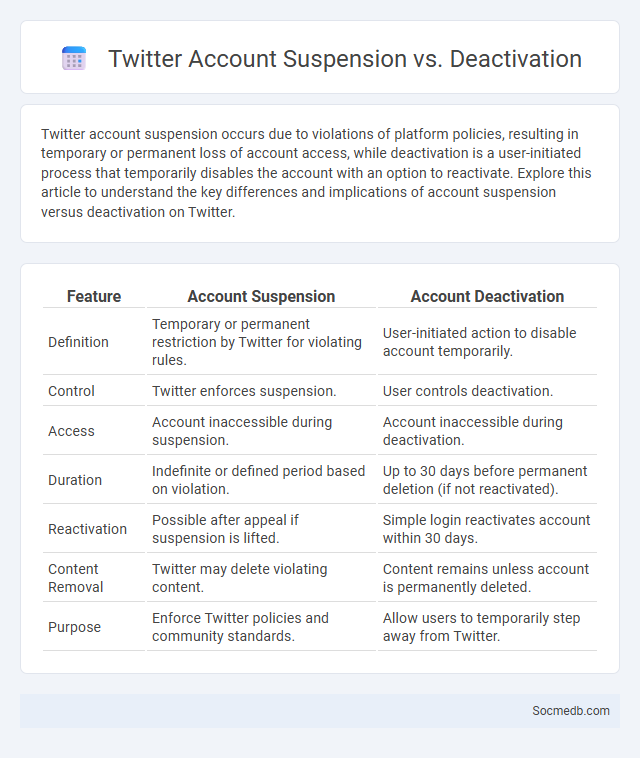
Photo illustration: Twitter Account Suspension vs Deactivation
Twitter account suspension occurs due to violations of platform policies, resulting in temporary or permanent loss of account access, while deactivation is a user-initiated process that temporarily disables the account with an option to reactivate. Explore this article to understand the key differences and implications of account suspension versus deactivation on Twitter.
Table of Comparison
| Feature | Account Suspension | Account Deactivation |
|---|---|---|
| Definition | Temporary or permanent restriction by Twitter for violating rules. | User-initiated action to disable account temporarily. |
| Control | Twitter enforces suspension. | User controls deactivation. |
| Access | Account inaccessible during suspension. | Account inaccessible during deactivation. |
| Duration | Indefinite or defined period based on violation. | Up to 30 days before permanent deletion (if not reactivated). |
| Reactivation | Possible after appeal if suspension is lifted. | Simple login reactivates account within 30 days. |
| Content Removal | Twitter may delete violating content. | Content remains unless account is permanently deleted. |
| Purpose | Enforce Twitter policies and community standards. | Allow users to temporarily step away from Twitter. |
Understanding Twitter Account Suspension
Understanding Twitter account suspension involves recognizing violations of platform rules, such as spam, abusive behavior, or security risks. Your account may be temporarily or permanently suspended depending on the severity of the offense and Twitter's review process. To avoid suspension, ensure compliance with Twitter's policies and promptly address any notifications from the platform.
What is Twitter Account Deactivation?
Twitter account deactivation is the process of temporarily disabling your Twitter profile, making your tweets, followers, and personal information invisible to other users. During the deactivation period, which lasts 30 days, you can reactivate your account by logging back in, restoring all your data without loss. If you do not reactivate within 30 days, Twitter permanently deletes your account and all associated content.
Key Differences Between Suspension and Deactivation
Suspension on social media platforms is a temporary action that restricts your account due to policy violations, often lasting for a specific time or until further review, whereas deactivation is a voluntary process that allows you to temporarily disable your account without penalties. Suspension typically involves the removal of user privileges and may result in loss of access to your content, while deactivation keeps your data intact but hidden from other users. Understanding these key differences helps you manage your social media presence effectively and maintain control over your digital footprint.
Common Reasons for Twitter Account Suspension
Twitter account suspension often results from violations of the platform's policies, including spam, abusive behavior, and misleading information. Engaging in coordinated harmful activities, such as harassment or spreading false news, significantly increases the risk of account removal. Understanding these common reasons helps you maintain compliance and protect your Twitter presence.
How Deactivation Works on Twitter
Deactivating a Twitter account temporarily removes the profile from public view and disables access to tweets, likes, and followers while preserving data for 30 days. During this deactivation period, users can reactivate their accounts by logging in, restoring all previous content and settings without loss. If the account remains inactive beyond 30 days, Twitter permanently deletes the profile and all associated data from its servers.
Consequences of a Suspended vs Deactivated Account
A suspended social media account often results from violations of platform policies and can lead to temporary or permanent loss of access, restricting your ability to engage with content and connect with others. Deactivating your account, however, is usually a voluntary action that temporarily hides your profile and content, allowing you the option to reactivate and restore your account later. Understanding these distinctions helps you manage your online presence and avoid unintended disruptions to your social media experience.
How to Recover from a Twitter Suspension
Recovering from a Twitter suspension requires first understanding the specific reason for your account being suspended, such as violating Twitter's rules regarding spam, abusive behavior, or security risks. You should carefully review Twitter's appeal process, submit a thorough and honest appeal through the Twitter Help Center, and provide any necessary information that supports your case. Maintaining compliance with Twitter's policies and avoiding repeated violations is essential to restoring Your account's functionality and preventing future suspensions.
Steps to Reactivate a Deactivated Twitter Account
To reactivate a deactivated Twitter account, log in with your username and password within 30 days of deactivation; after this period, the account is permanently deleted. Twitter restores all tweets, followers, and settings upon successful login during the reactivation window. If you fail to log in within 30 days, creating a new Twitter account is required as the original data cannot be recovered.
Preventing Twitter Suspension and Deactivation
Maintaining compliance with Twitter's rules and guidelines is essential for preventing account suspension and deactivation, including avoiding behaviors like spam, hate speech, and misinformation. Consistently monitoring account activity and promptly addressing any policy violations can reduce the risk of penalties. Implementing strong security measures such as two-factor authentication protects accounts from unauthorized access that might lead to suspension.
Frequently Asked Questions on Account Status
Account status on social media platforms indicates whether an account is active, suspended, or disabled, affecting user access and posting capabilities. Common questions include how to recover a suspended account, reasons behind account deactivation such as violations of community guidelines, and the timeframe for account review and reinstatement. Users frequently inquire about notifications related to status changes and steps to prevent future restrictions by adhering to platform policies.
 socmedb.com
socmedb.com